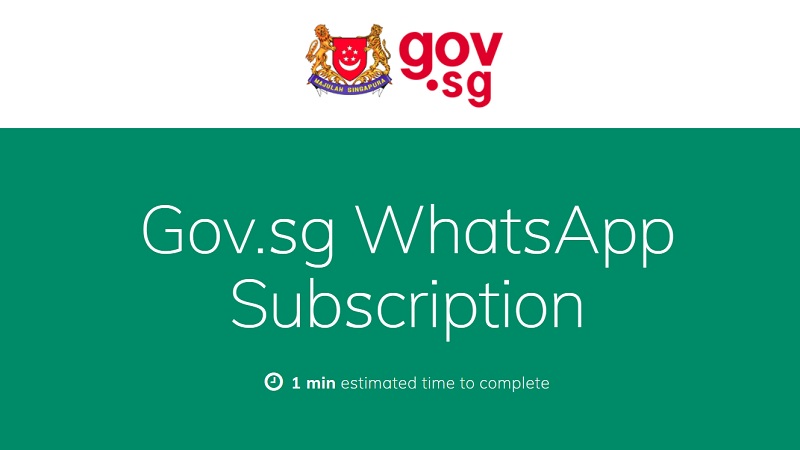It is the third day of the Chinese New Year, and amid festive reflections there is a pressing global health concern that demands careful attention to information as much as to infection control. The Wuhan Virus, now widely recognized as a novel coronavirus, is spreading variously across regions, and the world is facing the challenge of distinguishing accurate reporting from misinformation. In this context, rapid, reliable updates are crucial for public awareness and personal safety. Singapore has taken a concrete step to help citizens access trustworthy information quickly by launching an official information channel through a WhatsApp subscription service. This service is designed to cut through rumor and confusion by delivering verified updates directly to subscribers, reinforcing responsible reporting and informed action among the public. As the outbreak evolves, the emphasis on credible sources and disciplined sharing becomes essential to prevent panic and to ensure that resources—and people—are guided by facts rather than conjecture.
Official Information Channel and the WhatsApp Subscription Service
Singapore’s government rolled out a dedicated information channel via a WhatsApp subscription group to address the urgent need for accurate, timely guidance about the Wuhan Virus. The mechanism is straightforward, user-friendly, and purpose-built to minimize confusion in a rapidly changing situation. First, individuals subscribe by completing a simple form, after which they receive a WhatsApp message that instructs them on how to proceed to initiate their first conversation with the service. This design is intended to streamline access to official updates for a broad audience, including those who rely on mobile messaging as their primary means of receiving news and guidelines during a health emergency.
The process is intended to be as frictionless as possible, but the experience has shown that a surge in new subscribers can cause temporary delays. Acknowledging such delays is an important part of maintaining public trust; the initial automated message typically includes a brief apology for slower responses and explains the reason for the backlog—an influx of new subscribers that outpaced the service’s momentary capacity. This transparency helps set realistic expectations while the system scales to meet demand. Importantly, the content of the messages that follow is geared toward delivering concrete information about the current situation and practical steps that individuals can take to protect themselves and others.
Within the messages delivered through the channel, subscribers receive succinct, actionable updates about the Wuhan Virus. For example, there is confirmation of the current situation in Singapore, including the number of locally confirmed cases and any new developments that may affect daily life and safety protocols. The communications are crafted to be clear, direct, and timely, reducing the likelihood that recipients must sift through multiple sources to determine what is important at any given moment. By centralizing official guidance in a familiar and widely used platform, the government aims to contribute to a calmer, more informed public discourse during a period characterized by high uncertainty and rapid change.
It is worth noting that the content from the WhatsApp channel frequently addresses common questions and concerns that emerge in real time. In practice, this includes debunking rumors, explaining why certain measures are recommended, and outlining how the public can participate in collective efforts to reduce transmission risk. The overarching purpose is not only to convey the facts but also to provide practical context for interpreting new information as it arises. In this sense, the channel serves as a critical bridge between governments and citizens, helping to translate policy, scientific updates, and health recommendations into everyday actions.
To maximize accessibility, the messaging strategy is designed to reach a diverse audience, including people who may have limited access to traditional media but rely on mobile communications. The subscription service thus becomes a vital component of the broader public health information ecosystem, complementing official websites, press briefings, and other channels. The goal is to ensure that accurate information is easily reachable and that the public can quickly distinguish verified updates from rumor or speculation. In this way, the WhatsApp channel becomes a practical tool for reinforcing informed behavior and supportive community responses during a health crisis.
As with any information channel, the effectiveness of the WhatsApp subscription service depends on ongoing reliability, timely updates, and the clarity of messaging. In practice, this means consistent cadence, careful wording to avoid misinterpretation, and prompt corrections if new data suggests a revision of previous guidance. It also means safeguarding the integrity of the channel by limiting misinformation and ensuring that every update aligns with the best available public health guidance. The existence of this official channel represents a deliberate investment in transparent crisis communication—one that recognizes that accurate information is as essential as medical intervention in reducing harm during an outbreak.
In addition to delivering updates about the Wuhan Virus situation, the WhatsApp channel often reiterates critical practical guidelines, such as when to seek medical attention, how to protect vulnerable populations, and what behaviors can help minimize transmission. The emphasis remains on responsible, evidence-based information that can be acted upon by individuals, families, and communities. By centralizing these messages in a trusted source, the channel helps people avoid the confusion that can arise from piecemeal or unverified reporting across social media and other platforms. The net effect is a more informed public that can make better decisions about personal hygiene, social interactions, and adherence to public health recommendations.
Overall, the WhatsApp subscription service represents a forward-looking approach to health communication. It acknowledges the realities of digital information ecosystems in which misinformation can spread rapidly if not countered with timely, credible updates. The service is framed not as a substitute for official health authorities but as a practical extension of their work—an accessible conduit for distributing accurate information, dispelling false rumors, and guiding behavior that reduces risk for individuals and communities alike. As the outbreak continues to unfold, such official channels play a pivotal role in shaping informed responses and maintaining public confidence in the accuracy and usefulness of the guidance being provided.
Debunking Rumors and Upholding Information Accuracy
A central purpose of the official information channels is to counter rumors and misinterpretations that often accompany health emergencies. In the period surrounding the Wuhan Virus outbreak, rumors circulated widely online, sometimes claiming fatal outcomes or exaggerating the scale of the threat. The content disseminated by official channels explicitly addresses these rumors, emphasizing that not all statements circulating on social platforms are verified or accurate. For instance, rumors that a person had died from the Wuhan Virus in a Singapore shopping mall have been debunked by the Ministry of Health (MOH), which clarified that there were no deaths among suspect or confirmed cases. The corrective updates are presented not as sensational宣布 but as factual confirmations that help prevent unnecessary panic and misinformed decisions.
This approach to rumor management serves multiple purposes. First, it protects public health by reducing the likelihood that individuals will react to false information in ways that could harm themselves or others. Second, it preserves trust in official channels by consistently aligning public communications with validated information. When people see that rumors are being addressed directly and that MOH or other authorities provide clear explanations, they are more likely to rely on official guidance in future instances. Third, it helps prevent resource misallocation that can occur when people respond to misinformation—such as unnecessary purchases, evacuations, or avoidance of essential services—based on inaccurate reports.
The messaging about misinformation also includes guidance on how to assess the credibility of information encountered online or offline. Subscribing to official channels becomes a practical step for readers who want to minimize exposure to unverified claims. The communications emphasize that nothing is confirmed beyond the official reports at any given moment and that viewers should exercise caution before sharing content that they have not independently verified. In this way, the official updates function as both a source of truth and a teachable resource on media literacy during a health crisis.
Beyond debunking specific rumors, the information channels also provide explanations of why certain statements should be treated with skepticism. For example, they remind readers that numbers related to infection and mortality are sensitive to verification processes, testing capacity, and reporting conventions that may vary across settings and over time. This nuanced approach helps readers understand that apparent spikes or anomalies in data may reflect reporting cycles rather than actual changes in disease dynamics. The channels thus help readers interpret statistics more accurately and avoid overinterpretation or sensationalism.
Importantly, debunking efforts include guidance on how to verify a claim before sharing it. This includes checking whether a claim is supported by official sources, whether it cites a named authority, whether the information aligns with the latest public health guidance, and whether it has been consistently reported by multiple credible outlets. The emphasis on verification reduces duplication of misinformation and encourages a more thoughtful, responsible information culture during times of high information flux. By consistently addressing rumors with verified facts, official channels help to create a more stable information environment in which the public can make informed decisions.
The overall impact of rumor debunking in this context is to strengthen the public’s confidence in that official guidance while reducing the emotional triggers that often drive the spread of misinformation. When people see that authorities actively correct misinformation and provide clear, evidence-based explanations, they are more likely to adopt recommended behaviors, share only verified information, and seek updates from trustworthy sources. This dynamic supports not only individual health outcomes but also the effectiveness of broader public health strategies that rely on coordinated behavior across communities.
Public Health Guidance: Masks, Protection, and Resource Stewardship
A core element of the official health communications concerns protective measures and the rational use of resources, particularly personal protective equipment such as masks. The guidance emphasizes that, in general, individuals who are not ill do not need to wear a mask. A surgical mask is recommended for those who are unwell to reduce the likelihood of transmitting the virus to others. This distinction between prevention for the community and self-protection for the ill is central to efficient resource use and helps ensure that masks remain available for those who need them most.
The messaging also reassures the public about the adequacy of mask supplies, noting that there are sufficient masks in warehouses and government stockpiles as long as they are used responsibly. The call to responsible use and avoidance of hoarding is explicit, with the warning that hoarding can deprive those who genuinely require masks for medical reasons or to prevent transmission. This point underscores a broader principle of resource stewardship during a public health crisis: maintaining equitable access to essential supplies by prioritizing those with the greatest need and avoiding panic-driven stockpiling.
Communications emphasize that staying informed requires turning to official health portals for current recommendations and alerts. While general guidelines may evolve as the outbreak progresses, the underlying principles of mask use—appropriate circumstances, proper technique, and avoidance of unnecessary consumption—remain constant. The public is encouraged to follow updates from authorized health authorities and to apply the guidance in daily routines, workplaces, schools, and homes. Practical advice about mask usage is complemented by broader hygiene measures, including hand hygiene, respiratory etiquette, and social distancing where appropriate, all of which contribute to reducing transmission risk.
In addition to guidance about mask use, the official messages typically outline recommended actions for people who are not showing symptoms but are exposed to someone who may be infected, as well as steps for those who have traveled from affected areas. This information aims to strike a balance between prudent caution and maintaining normal activities where possible, thereby minimizing disruption while still prioritizing safety. The emphasis on practical steps helps people translate high-level public health concepts into concrete behaviors—such as proper mask-fitting techniques, safe disposal of used masks, and routine cleaning of frequently touched surfaces—that collectively contribute to a safer community environment.
The public health guidance also addresses the importance of reporting, testing, and clinical assessment for individuals with potential exposure or symptoms. By clarifying the thresholds for seeking medical care and the appropriate channels for contact, the messages help to prevent undue pressure on healthcare systems while ensuring that people who may be at risk receive timely evaluation. This approach to triage and care-seeking is designed to optimize resource allocation, protect vulnerable population groups, and support a rapid, coordinated public health response across different sectors of society.
Finally, the communications reinforce the broader narrative of solidarity and collective responsibility. The messages underscore that each person’s choices—including how they interpret information, how they respond to symptoms, and how they treat others—contribute to the community’s resilience. By framing protective actions as part of a shared duty to protect family, friends, colleagues, and neighbors, the official guidance seeks to motivate constructive behavior that reduces transmission risk and safeguards public health outcomes over the long term.
The Role of Responsible Sharing and Media Literacy
A critical takeaway accompanying the outbreak coverage is the emphasis on responsible sharing and media literacy. In the era of rapid digital communication, information travels faster than viruses, and not all of it travels with the same level of accuracy. The guidance explicitly encourages readers to be cautious about what they read, how they interpret it, and what they choose to forward or repost. This is not about censorship but about ensuring that the public has access to reliable, fact-checked information that supports safe decision-making and prevents unnecessary alarm.
The messages advocate for a deliberate, reflective approach to online content. This includes resisting the impulse to share sensational headlines or unverified claims and instead taking a moment to verify the source, cross-check details with official statements, and consider the potential consequences of disseminating unverified information. The recommended practice is to rely on official health portals and other credible authorities as primary sources for updates, while viewing social media as a secondary channel that should be used with caution and critical thinking.
Education about misinformation is framed as part of a broader public health strategy. By improving the public’s ability to assess information quality, authorities hope to reduce the spread of rumors that could hinder response efforts or cause unnecessary anxiety. The messaging is designed to be practical and actionable: it offers concrete steps for verifying claims, recognizing common misinformation patterns, and understanding why certain data points may be provisional or subject to revision as better information becomes available. This approach aims to cultivate a culture of careful communication that supports public health objectives rather than undermining them.
The emphasis on media literacy also has implications for how communities respond to outbreaks. When people are better equipped to filter misinformation, they can participate more effectively in protective measures and in community support activities. In turn, this contributes to more effective social cohesion and a more coordinated response from households, workplaces, schools, and local organizations. The end result is a more resilient society, capable of navigating uncertainty with evidence-based guidance rather than rumor-driven reactions.
In short, responsible sharing and media literacy are integral to the overall strategy of crisis communication during health emergencies. The combination of official, accessible information channels and a well-informed public creates a feedback loop that strengthens trust, clarifies expectations, and supports practical actions that reduce risk. The WhatsApp subscription service represents a tangible embodiment of this approach: it makes it easier for individuals to access verified information, which helps curb the spread of misinformation and promotes a more constructive public conversation about health and safety.
Practical Takeaways for Individuals and Families
For individuals and families seeking to navigate the Wuhan Virus situation with clarity and calm, several practical takeaways emerge from the official communications. First, prioritize information from official channels and avoid overreliance on unverified sources. The WhatsApp subscription service is one example of a structured, authoritative channel intended to deliver timely updates that can inform personal decisions. By subscribing, you gain a reliable line of communication that can help you stay current on developments, guidance, and any changes in recommendations as the situation evolves.
Second, be mindful of how you use protective measures. If you are not ill, routine precautions such as regular hand hygiene and staying home when sick remain important. If you are unwell, wearing a surgical mask is advised to prevent transmission to others, particularly in communal or indoor settings. The guidance emphasizes maintaining these practices without resorting to unnecessary stockpiling. By using resources responsibly, households can contribute to community-wide protection while ensuring that supplies remain available to those who need them most.
Third, cultivate a habit of verification before sharing. In a crisis, it is natural to want to help by passing along information that seems urgent or alarming. However, sharing unverified content can amplify misinformation and undermine public health efforts. Before forwarding any message, take a moment to check whether the claim is supported by official sources, whether it has been corroborated by credible outlets, and whether it remains accurate in light of the latest updates. If in doubt, refrain from sharing until you can confirm the information from a trusted source.
Fourth, maintain calm and context in your discussions about the outbreak. Hearing about dramatic numbers or alarming rumors can provoke anxiety, but measured, factual updates help families plan and respond appropriately. Discuss practical actions that you can take—such as reviewing household hygiene practices, ensuring adequate supplies without hoarding, and staying informed through official portals—to empower everyone in your circle to participate in safeguarding public health.
Fifth, stay attentive to changes in guidance. Public health recommendations can evolve as scientists learn more about the virus and as testing and reporting processes improve. Remaining attentive to official updates helps ensure that your responses remain aligned with the best available information. This adaptability is a strength of well-coordinated outbreak responses and a sign of resilient communities.
Finally, recognize the broader social responsibility that accompanies personal protection. Individual actions reverberate through families, workplaces, and neighborhoods. By adhering to evidence-based guidance, supporting those who may be more vulnerable, and engaging in constructive dialogue, you contribute to a culture of mutual care and collective resilience. The aim is not only to protect personal health but also to uphold the wellbeing of the wider community during a period of heightened risk and rapid developments.
A Path Forward: Communication, Trust, and Community Action
As the Wuhan Virus outbreak continues to unfold, the combination of credible information channels, clear health guidance, and a shared commitment to accuracy becomes increasingly important. The WhatsApp subscription service stands as a practical embodiment of this approach, offering a direct line to official updates while reinforcing the norms of responsible information sharing. By focusing on verified data, practical recommendations, and open acknowledgment of delays or evolving knowledge, public authorities can foster a climate of trust that supports both individual decision-making and collective safety.
Communication strategies that center on transparency, rapid yet accurate updates, and proactive rumor debunking can have a lasting positive impact on how communities respond to health emergencies. When people feel informed, they are more likely to act in ways that reduce transmission risk, seek timely medical advice when necessary, and resist the impulse to draw sweeping conclusions from incomplete or misleading information. In this sense, effective crisis communication is not ancillary to public health efforts; it is a core component that helps translate scientific understanding into everyday actions that protect lives.
Beyond the immediate outbreak, the lessons from this period emphasize the value of building robust information ecosystems that connect authorities with citizens in accessible, respectful, and collaborative ways. The integration of digital channels like the WhatsApp information service with traditional health guidance, media literacy initiatives, and community engagement efforts can produce a more resilient public health landscape. This approach supports continued vigilance, informed decision-making, and a shared sense of responsibility that strengthens societies as they navigate health threats now and in the future.
Conclusion
In the face of the Wuhan Virus outbreak, the priority remains clear: provide accurate, timely information; counter misinformation; and promote practical actions that protect individuals and communities. The third day of the Chinese New Year marked not only a moment of cultural reflection but also a reminder of the ongoing need for reliable updates and responsible communication. Singapore’s launch of an official WhatsApp information channel represents a concrete step toward accessible, trusted guidance, helping the public distinguish fact from rumor, understand when to seek care, and adopt protective behaviors without succumbing to panic. With four confirmed cases in Singapore at the time of reporting, and a broader global context of rising cases and evolving evidence, maintaining trust through transparent, fact-based messaging becomes essential. By subscribing to official channels, verifying information before sharing, and practicing practical, evidence-based health measures, individuals can contribute to a calm, informed, and resilient response to this public health challenge. The commitment to accuracy, responsibility, and community welfare remains the guiding principle as health authorities navigate uncertainty and work toward protecting lives.



